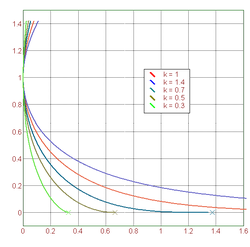
Curve of pursuit
Encyclopedia

Curve
In mathematics, a curve is, generally speaking, an object similar to a line but which is not required to be straight...
constructed by analogy to having a point
Point (geometry)
In geometry, topology and related branches of mathematics a spatial point is a primitive notion upon which other concepts may be defined. In geometry, points are zero-dimensional; i.e., they do not have volume, area, length, or any other higher-dimensional analogue. In branches of mathematics...
or points which represents pursuers and pursuees, and the curve of pursuit is the curve traced by the pursuers.
With the paths of the pursuer and pursuee parameterized in time, the pursuee is always on the pursuer's tangent
Tangent
In geometry, the tangent line to a plane curve at a given point is the straight line that "just touches" the curve at that point. More precisely, a straight line is said to be a tangent of a curve at a point on the curve if the line passes through the point on the curve and has slope where f...
. That is, given F(t) the pursuer (follower) and L(t) the pursuee (leader), there is for every t with F′(t) ≠ 0 an x such that

Multiple pursuers
Typical drawings of curves of pursuit have each point acting as both pursuer and pursuee, inside a polygonPolygon
In geometry a polygon is a flat shape consisting of straight lines that are joined to form a closed chain orcircuit.A polygon is traditionally a plane figure that is bounded by a closed path, composed of a finite sequence of straight line segments...
, and having each pursuer pursue the adjacent point on the polygon.
External links
- Mathworld, with a slightly narrower definition that |L′(t)| and |F′(t)| are constant

